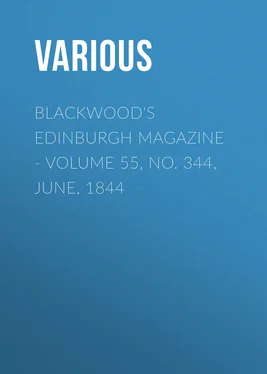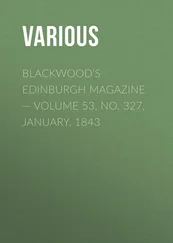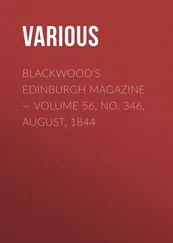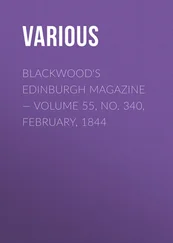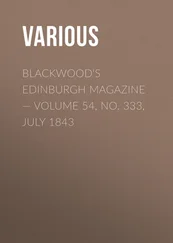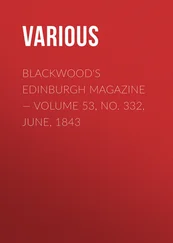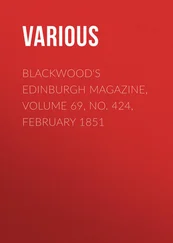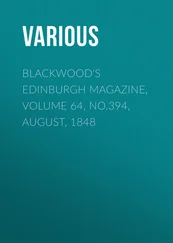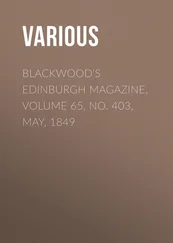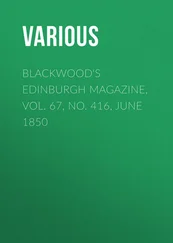Various - Blackwood's Edinburgh Magazine. Volume 55, No. 344, June, 1844
Здесь есть возможность читать онлайн «Various - Blackwood's Edinburgh Magazine. Volume 55, No. 344, June, 1844» — ознакомительный отрывок электронной книги совершенно бесплатно, а после прочтения отрывка купить полную версию. В некоторых случаях можно слушать аудио, скачать через торрент в формате fb2 и присутствует краткое содержание. Издательство: Иностранный паблик, Жанр: foreign_antique, periodic, foreign_edu, на английском языке. Описание произведения, (предисловие) а так же отзывы посетителей доступны на портале библиотеки ЛибКат.
- Название:Blackwood's Edinburgh Magazine. Volume 55, No. 344, June, 1844
- Автор:
- Издательство:Иностранный паблик
- Жанр:
- Год:неизвестен
- ISBN:нет данных
- Рейтинг книги:4 / 5. Голосов: 1
-
Избранное:Добавить в избранное
- Отзывы:
-
Ваша оценка:
- 80
- 1
- 2
- 3
- 4
- 5
Blackwood's Edinburgh Magazine. Volume 55, No. 344, June, 1844: краткое содержание, описание и аннотация
Предлагаем к чтению аннотацию, описание, краткое содержание или предисловие (зависит от того, что написал сам автор книги «Blackwood's Edinburgh Magazine. Volume 55, No. 344, June, 1844»). Если вы не нашли необходимую информацию о книге — напишите в комментариях, мы постараемся отыскать её.
Blackwood's Edinburgh Magazine. Volume 55, No. 344, June, 1844 — читать онлайн ознакомительный отрывок
Ниже представлен текст книги, разбитый по страницам. Система сохранения места последней прочитанной страницы, позволяет с удобством читать онлайн бесплатно книгу «Blackwood's Edinburgh Magazine. Volume 55, No. 344, June, 1844», без необходимости каждый раз заново искать на чём Вы остановились. Поставьте закладку, и сможете в любой момент перейти на страницу, на которой закончили чтение.
Интервал:
Закладка:
The steps by which the argument that Gil Blas is taken from a Spanish manuscript proceeds, are few and direct. It abounds in facts and allusions which none but a Spaniard could know: this is the first step. It abounds in errors that no Spaniard could make—(by the way, this is much insisted upon by M. de Neufchateau, who does not seem to perceive that, taken together with the preceding proposition, it is fatal to his argument:) this is the second step, and leads us to the conclusion that the true theory of its origin must reconcile these apparent contradictions.
A Spanish manuscript does account for this inconsistency, as it would furnish the transcriber with the most intimate knowledge of local habits, names, and usages; while at the same time it would not guard him against mistakes which negligence or haste, or the difficulty of deciphering a manuscript in a language with which the transcriber was by no means critically acquainted, must occasion. Still less would it guard him against errors which would almost inevitably arise from the insertion of other Spanish novels, or the endeavour to give the work a false claim to originality, by alluding to topics fashionable in the city and age when the work was copied.
The method we propose to follow, is to place before the reader each division of the argument. We shall show a most intimate knowledge with Spanish life, clearly proving that the writer, whoever he is, is unconscious of any merit in painting scenes with which he was habitually familiar. Let any reader compare the facility of these unstudied allusions with the descriptions of a different age or time, even by the best writers of a different epoch and country, however accurate and dramatic they may be—with Quentin Durward or Ivanhoe , for instance; or with Barante’s Histoire des Ducs de Bourgogne , and they will see the force of this remark. In spite of art, and ability, and antiquarian knowledge, it is evident that a resemblance is industriously sought in one case, and is spontaneous in the other; that it is looked upon as a matter of course, and not as a title to praise, by the first class of writers, while it is elaborately wrought out, as an artist’s pretension to eminence, in the second. If Le Sage had been the original author of Gil Blas, he would have avoided the multiplication of circumstances, names, and dates; or if he had thought it necessary to intersperse his composition with them, he would have contented himself with such as were most general and notorious; the minute, circuitous, and oblique allusions, which it required patient examination to detect, and vast local knowledge to appreciate, could not have fallen within his plan.
Secondly—We shall point out the mistakes, some of them really surprising even in a foreign writer, with regard to names, dates, and circumstances, oversetting every congruity which it was manifestly Le Sage’s object to establish. We shall show that the Spanish novels inserted by him do not mix with the body of the work; and moreover we shall show that in one instance, where Le Sage hazarded an allusion to Parisian gossip, he betrayed the most profound ignorance of those very customs which, in other parts of the work passing under his name, are delineated with such truth of colouring, and Dutch minuteness of observation.
If these two propositions be clearly established, we have a right to infer from them the existence of a Spanish manuscript, as on any other hypothesis the claims of an original writer would be clashing and contradictory.
M. Neufchateau, as we have observed, reiterates the assertion that the errors of Gil Blas are such as no Spaniard could commit, leaving altogether unguarded against the goring horn of the dilemma which can only be parried by an answer to the question—how came it to pass that Le Sage could enumerate the names of upwards of twenty inconsiderable towns and villages, upwards of twenty families not of the first class; and in every page of his work represent, with the most punctilious fidelity, the manners of a country he never saw? Nay, how came it to pass that, instead of avoiding minute details, local circumstances, and the mention of particular facts, as he might easily have done, he accumulates all these opportunities of mistake and contradiction, descends to the most trifling facts, and interweaves them with the web of his narrative (conscious of ignorance, as, according to M. Neufchateau, he must have been) without effort and without design.
Let us begin by laying before the readers the pièces du procès . First, we insert the description of Le Sage given by two French writers.
“Voici ce que disoit Voltaire à l’article de Le Sage, dans la première édition du Siècle de Louis XIV.:—
“‘Son roman de Gil Blas est demeuré, parcequ’il y a du naturel.’
“Dans les editions suivantes du Siècle de Louis XIV., Voltaire ajoute un fait qu’il se contente d’énoncer simplement, comme une chose hors de doute; c’est que Gil Blas est pris entièrement d’un livre écrit en Espagnol, et dont il cite ainsi le tître—La vidad de lo Escudero Dom Marco d’Obrego—sans indiquer aucunement la date, l’auteur, ni l’objet de cette vie de l’écuyer Dom Marco d’Obrego.”
“Extrait du Nouveau Porte-feuille historique, poetique, et litteraire de Bruzen de La Martinière.
“‘Baillet n’entendoit pas l’Espagnol. Au sujet de Louis Velés de Guevarra, auteur Espagnol, dans ses jugements des savants sur les poètes modernes, § 1461, il dit: On a de lui plusieurs comedies qui ont été imprimées en diverses villes d’Espagne, et une pièce facétieuse, sous le tître El Diabolo Cojuelo, novella de la otra vida: sur quoi M. de La Monnoye fait cette note. Comment un homme qui fait tant le modeste et le reservé a-t-il pu écrire un mot tel que celui-la? Cette note n’est pas juste. Il semble que M. de La Monnoye veuille taxer Baillet de n’avoir pas sontenu le caractère de modestie, qu’il affectoit. Baillet ne faisoit pas le modeste, il l’étoit véritablement par état et par principe; et s’il eût entendu le mot immodeste, ce mot lui auroit été suspect; il eut eu recours à l’original, où il auroit trouvé Diablo, et non Diabolo, Cojuelo et non Cojudo, et auroit bien vîte corrigé la faute. Mais comme il n’entendoit ni l’un ni l’autre de ces derniers mots, il lui fut aisé, en copiant ses extraits, de prendre un el pour un d , et de changer par cette légère différence Cojuelo, qui veut dire boiteux, en Cojudo, qui signifie quelqu’un qui a de gros testicules, et sobrino l’exprime encore plus grossièrement en François. M. de La Monnoye devoit moins s’arrêter à l’immodestie de l’épithète, qu’à la corruption du vrai tître le Guevarra.”
“Au reste, c’est le même ouvrage que M. La Sage nous a fait connoître sous le tître du Diable Boiteux; il l’a tourné, à sa manière, mais avec des différences si grandes que Guevarra ne se reconnoîtroit qu’à peine dans cette pretendue traduction. Par exemple, le chapitre xix de la seconde partie contient une aventure de D. Pablas, qui se trouve en original dans un livre imprimé à Madrid en 1729, (sic.) L’auteur des lectures amusantes, qui ne s’est pas souvenu que M. Le Sage, en avoit inséré une partie dans son Diable Boiteux, l’a traduite de nouveau avec assez de liberté, mais pourtant en s’écartant moins de l’original, et l’a insérée dans sa première partie à peu près telle qu’elle se lit dans l’original Espagnol. Mais M. Le Sage l’a traitée avec de grands changements, c’est sa manière d’embellir extrêmement tout ce qu’il emprunte des Espagnols. C’est ainsi qu’il en a usé envers Gil Blas, dont il a fait un chef-d’œuvre inimitable.”—(Pages 336-339, édition de 1757, dans les Passetemps Politiques, Historiques, et Critiques , tome 11, in 12.)
Читать дальшеИнтервал:
Закладка:
Похожие книги на «Blackwood's Edinburgh Magazine. Volume 55, No. 344, June, 1844»
Представляем Вашему вниманию похожие книги на «Blackwood's Edinburgh Magazine. Volume 55, No. 344, June, 1844» списком для выбора. Мы отобрали схожую по названию и смыслу литературу в надежде предоставить читателям больше вариантов отыскать новые, интересные, ещё непрочитанные произведения.
Обсуждение, отзывы о книге «Blackwood's Edinburgh Magazine. Volume 55, No. 344, June, 1844» и просто собственные мнения читателей. Оставьте ваши комментарии, напишите, что Вы думаете о произведении, его смысле или главных героях. Укажите что конкретно понравилось, а что нет, и почему Вы так считаете.
